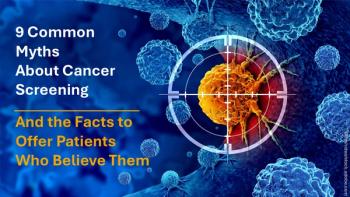
Updated Guidelines Give Thumbs Down on PSA Screening in Older Men
To screen or not to screen? The answer is not straightforward when it comes to prostate cancer. Recently updated guidelines from the US Preventive Services Task Force (USPSTF) recommend against prostate- specific antigen (PSA) screening in men who are 75 years and older and state that there is insufficient evidence to confirm whether screening is beneficial-or harmful -to men younger than 75 years.1,2 The recommendations are summarized in the Table.
To screen or not to screen? The answer is not straightforward when it comes to prostate cancer. Recently updated guidelines from the US Preventive Services Task Force (USPSTF) recommend against prostate- specific antigen (PSA) screening in men who are 75 years and older and state that there is insufficient evidence to confirm whether screening is beneficial-or harmful -to men younger than 75 years.1,2 The recommendations are summarized in the Table.
DEBATE OVER PSA SCREENING
The previous recommendations, published in 2002, found insufficient evidence to conclude whether screening for prostate cancer improved health outcomes or reduced associated mortality.3 In addition, little evidence was available at the time to determine whether screening caused harm. More current data suggest that men older than 75 years generally will not become symptomatic in their lifetime when prostate cancer is diagnosed by PSA screening-as opposed to a diagnosis made through a clinical examination in which palpable findings are detected.4-6
Whereas treatment of clinically diagnosed cases significantly reduces disease progression and metastasis and somewhat reduces mortality,6,7 treatment of cases diagnosed by PSA screening has little impact on mortality in older men and is linked to morbidity. 1,2,6 Even in younger men, the confirmed value of treatment is based on data associated with clinical diagnosis, not screening-based diagnosis.6 Issues that require further clarification include the following:
•Overdiagnosis.
•PSA level cut-points used to diagnose prostate pathology.
•Lead time between a diagnosis based on screening and the manifestation of clinical signs and symptoms of cancer (Figure).6
POTENTIAL HARMS OF SCREENING
A major change from the previous USPSTF recommendations is the discussion of the harms associated with PSA screening. The patient may experience discomfort during the screening process, such as pain related to prostate biopsy. In addition, false-positive results can lead to anxiety, sexual dysfunction, and the perception of being at risk in some patients. 1 As a result, an increased use of health care resources in the form of repeated testing and biopsy was noted among patients who receive false-positive results.1
The true magnitude of harm instigated by false-positive PSA screening results-and overdiagnosis for that matter-is unknown, in part because the current data are drawn “almost exclusively” from college-educated white men.1 Although studies have been done to determine how to increase rates of screening for prostate cancer among African American men, no studies have been conducted to examine the impact of false-positive screening results in this population, in which the incidence of and mortality related to prostate cancer is higher than in white men.
Because complications of treatment can include sexual dysfunction as well as urinary and bowel incontinence- in addition to mortality- the decision to proceed with aggressive intervention based on screening results should be weighed carefully. Indeed, physicians are advised to fully disclose to patients the known risks, benefits, and equivocations of screening and treatment.1
References:
REFERENCES:
1
. US Preventive Services Task Force. Screeningfor prostate cancer: US Preventive Services TaskForce recommendation statement.
Ann Intern Med.
2008;149:185-191.
http://www.annals.org/cgi/content/full/149/3/185
.
2
. Lin K, Lipsitz R, Miller T, Janakiraman S;US Preventive Services Task Force. Benefits andharms of prostate-specific antigen screening forprostate cancer: an evidence update for theUS Preventive Services Task Force.
Ann InternMed.
2008;149:192-199.
3
. Harris R, Lohr KN. Screening for prostate cancer:an update of the evidence for the US PreventiveServices Task Force.
Ann Intern Med.
2002;137:917-929.
4
. Roemeling S, Roobol MJ, Postma R, et al. Managementand survival of screen-detected prostatecancer patients who might have been suitable foractive surveillance.
Eur Urol.
2006;50:475-482.
5
. Roemeling S, Roobol MJ, de Vries SH, et al.Active surveillance for prostate cancers detected inthree subsequent rounds of a screening trial:characteristics, PSA doubling times, and outcome.
Eur Urol.
2007;51:1244-1251.
6
. Etzioni R, Penson DF, Legler JM, et al. Overdiagnosisdue to prostate-specific antigen screening: lessonsfrom the U.S. prostate cancer incidence trends.
J Natl Cancer Inst.
2002;94:981-990.
7
. Bill-Axelson A, Holmberg L, Ruutu M, et al;Scandinavian Prostate Cancer Group Study No. 4.Radical prostatectomy versus watchful waitingin early prostate cancer.
N Engl J Med.
2005;352:1977-1984.
Newsletter
Enhance your clinical practice with the Patient Care newsletter, offering the latest evidence-based guidelines, diagnostic insights, and treatment strategies for primary care physicians.





























































































































































































































































































